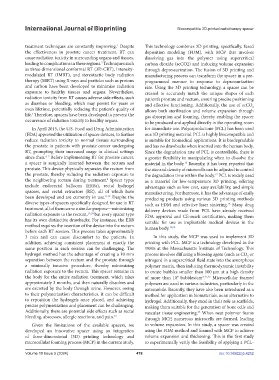Page 486 - IJB-10-5
P. 486
International Journal of Bioprinting Biocompatible 3D-printed radiotherapy spacer
treatment techniques are constantly improving. Despite This technology combines 3D printing, specifically, fused
1
the effectiveness in prostate cancer treatment, RT can deposition modeling (FDM), with MCP that involves
cause radiation toxicity in surrounding organs and tissues, dissolving gas into the polymer using supercritical
leading to complications in these regions. Techniques such carbon dioxide (scCO2) and inducing volume expansion
2
as three-dimensional conformal RT (3D-CRT), intensity- through depressurization. The fusion of 3D printing and
modulated RT (IMRT), and stereotactic body radiation manufacturing process can transform the spacer in a pre-
therapy (SBRT) using X-rays and particles such as protons programmed manner in response to depressurization
and carbon have been developed to minimize radiation rate. Using the 3D printing technology, a spacer can be
exposure to healthy tissues and organs. Nevertheless, created to accurately match the unique shapes of each
radiation toxicity from RT causes adverse side effects, such patient’s prostate and rectum, ensuring precise positioning
as diarrhea or bleeding, which may persist for years or and effective functioning. Additionally, the use of scCO
2
even lifetime, potentially reducing the patient’s quality of allows both sterilization and volume expansion through
life. Therefore, spacers have been developed to prevent the gas absorption and foaming, thereby enabling the spacer
3
occurrence of radiation toxicity to healthy organs. to be produced and applied directly in the operating room
In April 2015, the U.S. Food and Drug Administration for immediate use. Polycaprolactone (PCL) has been used
(FDA) approved the utilization of spacer devices, to further as a 3D printing material. PCL is highly biocompatible and
reduce radiation toxicity to normal tissues surrounding is suitable for biomedical applications. It is biodegradable
the prostate in patients with prostate cancer undergoing and has no drawbacks when inserted into the human body.
RT, prompting their increased usage in clinical settings Since the degradation rate of PCL is controllable, there is
since then. Before implementing RT for prostate cancer, a greater flexibility in manipulating when to dissolve the
4–7
a spacer is surgically inserted between the rectum and material in the body. Recently, it has been reported that
16
prostate. This device physically separates the rectum from the size and density of microcells can be adjusted to control
the prostate, thereby reducing the radiation exposure to the degradation time within the body. PCL is widely used
17
the neighboring rectum during treatment. Spacer types as a material for low-temperature 3D printing, offering
8
include endorectal balloons (ERBs), rectal hydrogel advantages such as low cost, easy availability, and simple
spacers, and rectal retractors (RR), all of which have manufacturing. Furthermore, it has the advantage of easily
been developed and are currently in use. 9–12 Despite the producing products using various 3D printing methods
diverse types of spacers specifically designed for use in RT such as FDM and selective laser sintering. Many drug
18
treatment, all of them serve a similar purpose—minimizing delivery devices made from PCL have already received
radiation exposure to the rectum, 13,14 but every spacer type FDA approval and CE-mark certification, making them
has its own distinctive drawbacks. For instance, the ERB suitable for use as implantable medical devices in the
method requires the insertion of the device into the rectum human body. 19,20
before each RT session. This process takes approximately
3 min and can cause discomfort to the patients. In In this study, the MCP was used to implement 3D
addition, achieving consistent placement at exactly the printing with PCL. MCP is a technology developed in the
same position in each session can be challenging. The 1980s at the Massachusetts Institute of Technology. This
hydrogel method has the advantage of creating a 10 mm process involves diffusing a blowing agent (such as CO or
2
separation between the rectum and the prostate through nitrogen) in a supercritical fluid state into the amorphous
a minimally invasive procedure, thereby minimizing polymer matrix, then inducing thermodynamic instability
radiation exposure to the rectum. This spacer remains in to create bubbles smaller than 100 μm at a high density
the body for the entire radiation treatment, which takes of more than 10 bubbles/cm . Microcellular foamed
3 21,22
9
approximately 3 months, and then naturally dissolves and polymers are used in various industries, particularly in the
are excreted by the body through urine. However, owing automobile. Recently, they have also been introduced as a
to their polymerization characteristics, it can be difficult method for application in biomaterials, as an alternative to
to reposition the hydrogels once placed, and achieving hydrogel. Additionally, they excel in their role as scaffolds,
precise polymerization and placement can be challenging. making them suitable for the generation of bone cells and
Additionally, there are potential side effects such as rectal vascular tissue engineering. When neat polymer foams
23
bleeding, abscesses, allergic reactions, and pain. 15 through MCP, numerous microcells are formed, leading
Given the limitations of the available spacers, we to volume expansion. In this study, a spacer was created
developed an innovative spacer using an integration using the FDM method and foamed with MCP to achieve
of three-dimensional (3D) printing technology and volume expansion and thickening. This is the first study
microcellular foaming process (MCP) in the current study. to experimentally verify the feasibility of applying a PCL-
Volume 10 Issue 5 (2024) 478 doi: 10.36922/ijb.4252

